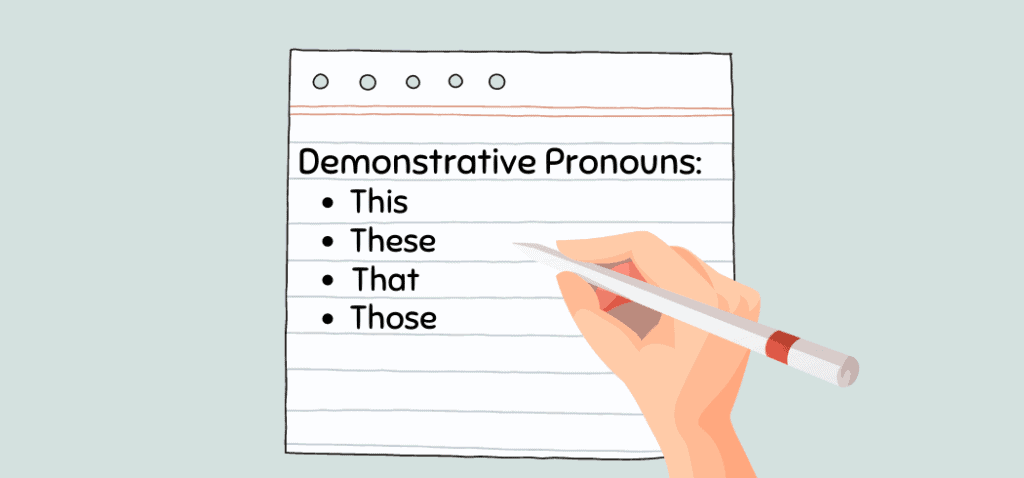This, that, these, and those are what we call demonstrative pronouns because they point to certain nouns depending on the distance.
Keep reading as I explain the definition and even provide a complete list of demonstrative pronouns in English. This guide also explains the correct pronoun usage and then provides a practice worksheet to test your understanding.
Demonstrative Pronoun Definition
A demonstrative pronoun is a kind of pronoun used to point to something explicit in the same sentence. Remember that a pronoun replaces people, things, places, or events in sentences.

This type of pronoun represents an object that is either near or far in time or distance. They include this, these, that, and those. For example:
- These are nice shoes, but the heels are too high.
These is the subject of the sentence, representing shoes. The speaker or writer may be currently wearing the shoes as they are narrating.
The previous sentence example shows how important context is when using a demonstrative pronoun in writing. Using it in speech makes it easy to point to the object and use other body language signals. But when writing, you need to be more descriptive.
Demonstrative pronouns sometimes function as demonstrative adjectives because they modify nouns and pronouns. For instance, in the phrase this apple, this modifies the object apple. Therefore, it is in adjective form.
Pronouns come in other forms, such as personal pronouns, indefinite pronouns, reflexive pronouns, interrogative pronouns, possessive pronouns, reciprocal pronouns, and intensive pronouns.
What are the Examples of Demonstrative Pronouns?
Here is my list of demonstrative pronoun examples. These pronouns can be singular or plural.
Singular Demonstrative Pronouns
Here’s a list of demonstrative pronouns in singular forms.
- This (points to a close object, person, place, or event).
- That (points to a faraway object, person, place, or event).
Plural Demonstrative Pronouns
Demonstrative pronouns also have plural forms.
- These (points to close objects, persons, places, or events).
- Those. (points to faraway objects, persons, places, or events).
Demonstrative pronouns are gender-neutral pronouns. However, in other foreign languages like Spanish, demonstrative pronouns include female pronouns and masculine pronouns.
How to Use Demonstrative Pronouns

Visual distance is critical to the use of demonstrative pronouns. Here are some examples of demonstrative pronouns in sentences.
- These flowers are so beautiful.
- That is an amazing sweatshirt you’re wearing.
In the first sentence, these refers to the noun flowers, which is in its plural form. It’s also safe to assume that the speaker is currently holding the flowers because they are saying these instead of those.
Sometimes, demonstrative pronouns are not specifically named in the sentence. For example:
- I can’t believe this is happening.
The sentence doesn’t show what this means. However, we’re sure that it’s something that the writer cannot believe is happening. The use of this also implies that it is currently happening.
A demonstrative pronoun can also describe a proper noun, especially an identified person. For example:
- That looks like Taylor.
Here, that refers to Taylor, a proper noun for a person.
You might notice that some AI editors or grammar tools ask you to add the antecedent for demonstrative pronouns in your sentences. But this isn’t always necessary, especially if your message is clear.
For instance, it’s okay to say I can’t believe this is happening without mentioning what’s happening in the same sentence. As long as you mention it in the previous or following sentences, then you don’t need to worry.
That as a Demonstrative Pronoun and Relative Pronoun
Aside from being a demonstrative pronoun and adjective, that also functions as a relative pronoun. That becomes a relative pronoun when it introduces a specific type of clause. For example:
- I went to the store that offered 50% off on school supplies.
The sentence above uses that to introduce the relative clause, that offered 50% off on school supplies.
Can You End a Sentence with a Demonstrative Pronoun?
Yes, you can end your English sentences with demonstrative pronouns. For example:
- Joan gave me those.
A preposition is the only part of speech you should not use at the end of sentences.
What is the Importance of Demonstrative Pronouns?
Demonstrative pronouns are types of pronouns that help avoid repetition when writing or talking in the English language. It represents an exact noun or a string of noun phrases already mentioned in the sentence.
Unlike personal pronouns, demonstrative pronouns also imply some sort of distance in length or time.
These pronouns are also essential for young English speakers and writers to develop more grammar skills. It’s a huge step toward producing complex sentences and any other sentence structure.
Examples of Demonstrative Pronouns in a Sentence
Here are more examples of demonstrative pronouns in sentences.
- This is not what I expected.
- The towel is wet. What should I do with this?
- That is my favorite vegetable.
- That’s the way to the lake.
- These are the thickest books I’ve ever seen.
- I want to get five of these.
- Could you bring those for me?
- Those were my wishes when I was young.
Demonstrative Pronouns are Important
Numerous languages have their own demonstrative pronouns, all working to point to specific things in terms of distance or time. This class of pronouns includes this, that, these, and those in English.
Now you know the demonstrative pronoun’s definition and correct usage. Use them correctly in sentences and differentiate them from demonstrative adjectives.